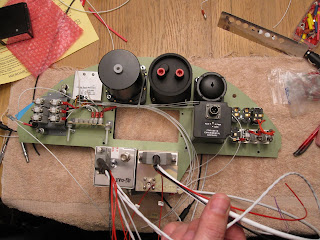


Tom has almost completed the wiring for the instrument panel. The layout has evolved somewhat so that a few critical circuit breakers are located on the panel and a few non-critical breakers are located on a sub-panel hidden behind the AV80R GPS/Moving map. The AV80R has buttons located on its edges so it has to be surface mounted on the face of the panel. It snaps out easily for use in the "land mode".



"Eyeball" fittings are used for the signal wire penetrations through the firewall. Having the right tools really comes in handy for tasks like sizing the holes in the two-piece eyeball to the appropriate size for the wire bundle. Les set these up in his mill and sized the holes as required.

No comments:
Post a Comment